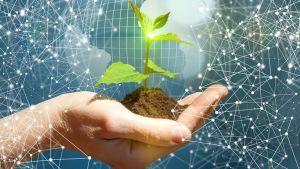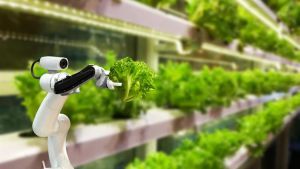Technology in Horticulture for Reliable and Optimized Food Production

(5 min read)
As the world’s population continues to expand, traditional food production is under pressure from a changing climate as well as dwindling land and water resources. The good news is that technology already provides tangible solutions to some of these challenges. And I want to tell you more about them, especially with respect to horticulture and the overall future of crop production.
Facing climate change as well as an increasing world population raises the question: how can we ensure our food production is reliable and of stable quality? Is there a way to produce food in controlled environments, independent of fluctuating weather and temperature?
I believe technology can already answer both questions. Maybe that makes me sound like I’m a visionary, but I’m just a technology fan excited about a changing industry. Over the years, I’ve gained a lot of experience in projects implementing technology for horticultural issues. Here are a few of the things I’m most excited about.
Automation in the Garden
There are robots to vacuum your home, clean your windows, cut the grass in your garden. What if there was also a robot that automatically seeds, waters, weeds, and harvests your plants? That’d be cool, right? It’s just one way technology can be used for gardening – and it’s already happening. A good example is the FarmBot, which is a raised-bed garden with a robotic tender. It’s still in its infancy, but the technology promises to achieve a level of efficiency in food production that a human could never reach.
When my colleagues and I saw FarmBot, it was like a window into the future. Technology was making an individual gardener’s life easier. What we asked each other was: How might technology optimize food production beyond automated gardens?
The potential for digitalization is tremendous. Networked, automated gardens could allow individuals to plan and manage their plots remotely, while at work or on vacation. No need for anyone to water the plants! What’s more, gardens could be managed in groups rather than individually.
Ensuring Constant Crop Quality
Take a look at the big picture – what can we achieve with that technology? How could this technology affect our way of producing food in the future? Robots can already seed, cultivate, and harvest plants. Moreover, sensors can better capture data that can be used to set up closed loop controls that govern a robot’s actions. The result is a level of reliability, replicability, and quality control that has never before existed in food production.
A reliable and optimized system can ensure planning security for suppliers and customers. This is especially beneficial to, for example, producers of medicinal herbs or plant-based pharmaceuticals who depend on consistent quality.

Machine learning and big data management are key to gleaning further insights from the plant growth data collected in these controlled environments. What we learn could be used to optimize light, soil conditions, plant spacing, or other variables that could further speed up the production cycle or help us produce more nutrient-rich food. Such data may form the foundation for a company’s ultimate success, shaping algorithms and driving further optimization.
Growing Food in Controlled Environments
Optimal light conditions for crops isn’t just a matter of going to the hardware store and hanging some bulbs. It means there is a need for producers of LEDs with a specific wavelength that stimulates photosynthesis. High-tech sensors are another related technology that will mature along with changing food production. These sensors will have to collect massive amounts of data about, for example, the nutritional value and moisture in soil, about plant growth, and about light.
What if these automated gardens – really what we’re talking about now are farms – were in metropolitan areas? These technological developments could bring opportunities to grow plants not just on the ground but also up walls or on elevated platforms. This is called vertical or urban farming.

In addition to traditional farms outside the cities, we might have small vertical farms as a local complement within cities. Through leveraging these new technologies and bringing them into the cities, we could reduce transportation and logistics costs as well as CO2 emissions. You probably realize that there are many new ways and ideas how to produce and transport food, creating a new digitalized branch of the food industry becoming more willing to implement high-tech.
A number of companies in Europe, Asia, and the United States have already found success with vertical farming business models. Because they’re located in urban areas, logistics costs are lower. By using technology and optimizing growth conditions, they use up to 95% less water than traditional farms, and, in some cases, produce zero agricultural runoff. And because they’re inside – and vertical – they use less land, too.
Other Supportive Technologies
Technology is paving a way into the future of agriculture in other ways too. I’m thinking of drone technology. It has provided perhaps the most high-profile technological advancement in the world of agricultural and land management so far. Last year, we had an exciting project that used drones, remote sensing, and AI to help identify and eradicate a dangerous invasive plant species in Denmark known as the Giant Hogweed.
Other companies, like Dendra, use similar drone technology to automate seed planting. These drones work to disperse seeds of native plants and trees and help restore ecosystems.
Both projects show how digital transformation is changing the farmers’ process of planting and managing vegetation. The practice of using drones and other technology to more closely and effectively manage a farm already has its own name: precision farming.
I’m sure – as with drones, robotics, and controlled farming – that we will soon discover even more technologies that will benefit all scales of food production. We are just at the beginning.
Designing the Future of Horticulture and Agriculture
Urban farming is already here. Drones are already out there buzzing around. At NTT DATA Business Solutions, we’re committed to looking for more ways to bring high-tech solutions – like AI, machine learning, and big-data management – to the crop and food production industry. It’s a subject I’d love to speak to you about. Please don’t hesitate to get in touch.
Discover More Technologies
Want to know more also about AI, robot process automation, machine learning and IoT? These are complex topics, but let’s take a look into the future together.